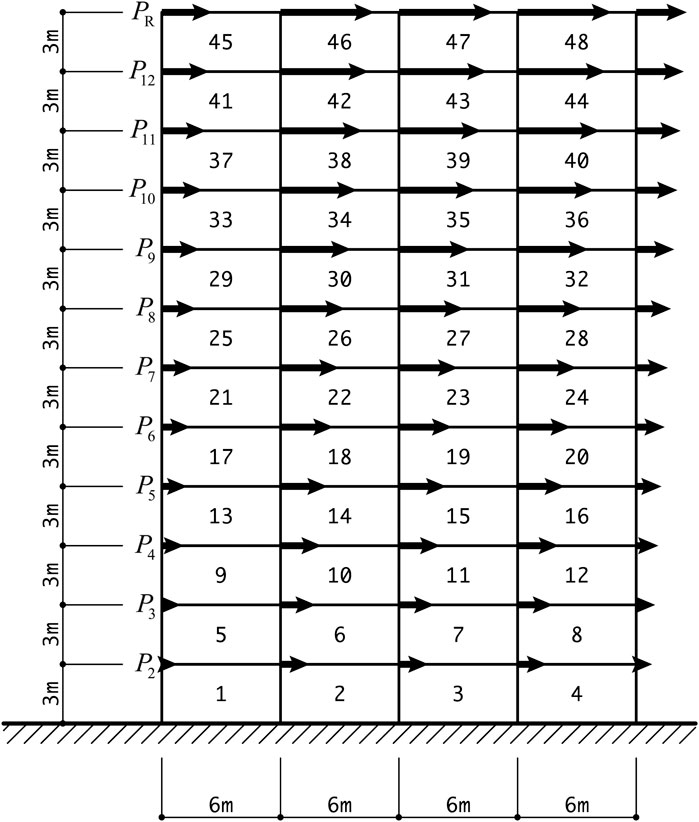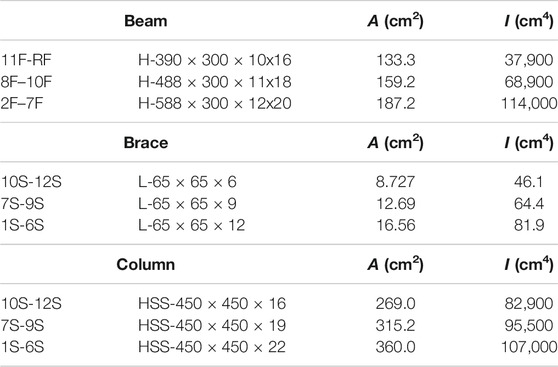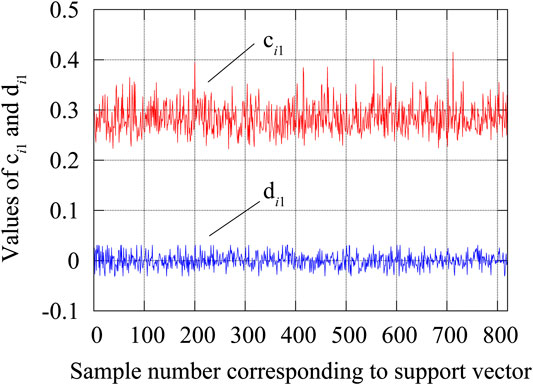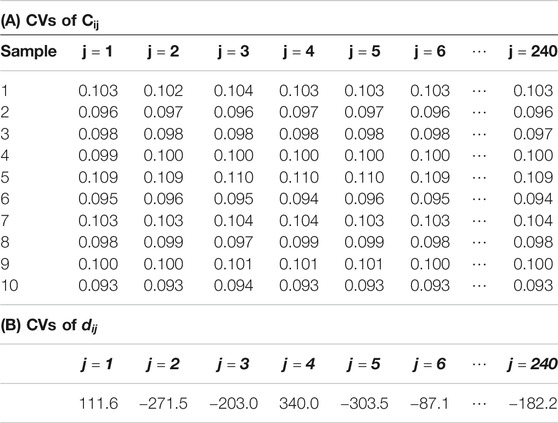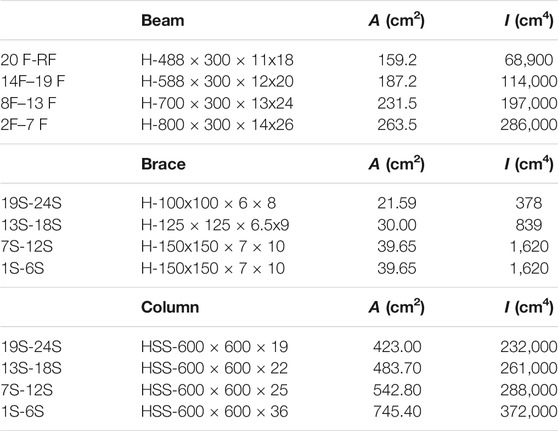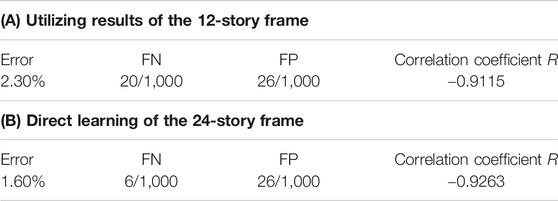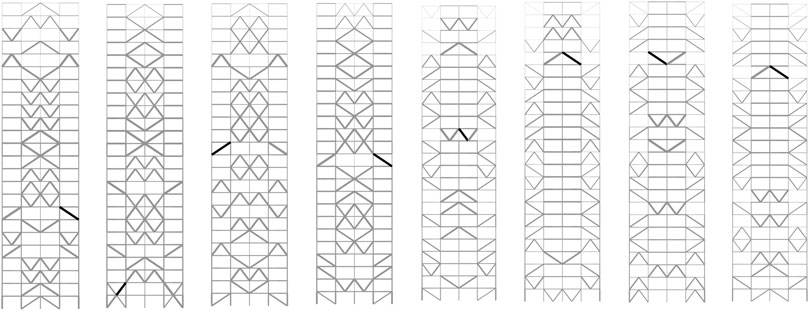- 1Department of Architecture and Architectural Engineering, Kyoto University, Kyoto, Japan
- 2Graduate School of Design and Architecture, Nagoya City University, Nagoya, Japan
A method is presented for extracting features of approximate optimal brace types and locations for large-scale steel building frames. The frame is subjected to static seismic loads, and the maximum stress in the frame members is minimized under constraints on the number of braces in each story and the maximum interstory drift angle. A new formulation is presented for extracting important features of brace types and locations from the machine learning results using a support vector machine with radial basis function kernel. A nonlinear programming problem is to be solved for finding the optimal values of the components of the matrix for condensing the features of a large-scale frame to those of a small-scale frame so that the important features of the large-scale frame can be extracted from the machine learning results of the small-scale frame. It is shown in the numerical examples that the important features of a 24-story frame are successfully extracted using the machine learning results of a 12-story frame.
Introduction
The optimization problem of brace locations on a plane frame is a standard problem that has been extensively studied over the past few decades (Ohsaki 2010). However, it is categorized as a topology optimization problem that involves integer variables indicating the existence/nonexistence of members. Therefore, it is more difficult than a sizing optimization problem, where the cross-sectional properties are considered as continuous design variables and their optimal values are found using a nonlinear programming algorithm. Furthermore, another difficulty exists in the problem with stress constraints (Senhola et al., 2020), which are to be satisfied by only existing members; therefore, the constraints are design-dependent, and the problem becomes a complex combinatorial optimization problem.
The solution methods for combinatorial optimization problems are categorized into mathematical programming and heuristic approaches. For a truss structure, the topology optimization problem with stress constraints can be formulated as a mixed-integer linear programming (MILP) problem (Kanno and Guo, 2010). However, the computational cost for solving an MILP problem is very large, even for a small-scale truss. By contrast, various heuristic methods, including genetic algorithms, simulated annealing (Aarts and Korst, 1989), tabu search (Glover, 1989), and particle swarm optimization (Kennedy and Eberhart, 1995), have been proposed for topology optimization problems (Saka and Geem, 2013). Hagishita and Ohsaki (2008a) proposed a method based on the scatter search. Some methods have been proposed for generating brace locations using the technique of continuum topology optimization (Rahmatalla and Swan, 2003; Beghini et al., 2014). However, the computational cost of a heuristic approach is also very large for a structure with many nodes and members. Therefore, the computational cost may be substantially reduced if a solution that cannot be an approximate optimal solution or a feasible solution is excluded before carrying out structural analysis. For this purpose, machine learning can be effectively used.
Machine learning is a basic process of artificial intelligence, the use of which has resulted in great successes in the field of pattern recognition (Carmona et al., 2012). Support vector machine (SVM) (Cristianini and Shawe-Taylor, 2000), artificial neural network (ANN) (Adeli, 2001), and binary decision tree (BDT), are regarded as the most popular methods. The application of machine learning to the solution process of optimization problems has been studied by many researchers, including Szczepanik et al. (1996) and Turan and Philip (2012). Probabilistic models, including Bayesian inference, Gaussian process model (Okazaki et al., 2020), and Gaussian mixture model (Do and Ohsaki, 2020), have also been extensively studied.
The application of machine learning to structural response analysis and structural optimization has been studied since the 1990s in conjunction with data mining approaches (Hagishita and Ohsaki, 2008b; Witten et al., 2011). The use of machine learning is categorized into several levels. The simplest level is to estimate the structural responses that are to be obtained by complex nonlinear and/or dynamic analysis, demanding a large computational cost. For example, SVM for regression (Smola and Schölkopf, 2004; Luo and Paal, 2019) has successfully been applied to reliability analysis (Li et al., 2006; Liu et al., 2017b; Dai and Cao, 2017), and ANN (Papadrakakis et al., 1998; Panakkat and Adeli, 2009), including deep neural network (DNN) (Nabian and Meidani, 2018; Yu et al., 2019), can be used for estimating multiple response values. Nguyen et al. (2019) used DNN for predicting the strength of a concrete material. Abueidda et al. (2020) used DNN for finding the optimal topology of a plate with material nonlinearity. The approaches in this level are regarded as surrogate or regression models which are similar to the conventional methods of response surface approximation, Gaussian process model, etc. (Kim and Boukouvala., 2020). Most of the research on machine learning for structural optimization are classified into this level. The computational cost for structural analysis during the optimization process can be drastically reduced using machine learning for constructing a surrogate model.
The second-level application of machine learning to structural optimization may be to classify the solutions into two groups, such as feasible and infeasible solutions or approximate optimal and non-optimal solutions. During the optimization process using a heuristic method, the solutions judged as infeasible or non-optimal can be simply discarded without carrying out structural analysis. Cang et al. (2019) applied machine learning to an optimization method using the optimality criteria approach. Liu et al. (2017a) used clustering for classifying the solutions. Kallioras et al. (2020) used deep belief network for accelerating the topology optimization process. Various methods of data mining can be used for classifying the solutions; however, the number of studies included in this level is rather small. In this paper, we extend the method using SVM in our previous paper (Tamura et al., 2018) to classify the brace types and locations of a large-scale frame.
The most advanced use of machine learning in structural optimization may be to directly find the optimal solution without resorting to an optimization algorithm. Several approaches have been proposed for learning the properties of optimal solutions of plates subjected to in-plane loads (Lei et al., 2018). However, it is difficult to estimate the properties of optimal solutions with enough precision so as to find the optimal solutions without using an optimization algorithm. Alternatively, reinforcement learning may be used for training an agent, simulating the decision-making process of an expert (Yonekura and Hattori, 2019; Hayashi and Ohsaki, 2020a, Hayashi and Ohsaki, 2020b).
One of the drawbacks in the application of machine learning to structural optimization is that the computational cost for generating the sample dataset for learning and the process of learning itself may exceed the reduction of the computational cost for optimization by utilizing the learning results. Therefore, it is important to develop a method such that the machine learning results of a small-scale model can be utilized for extracting the features of approximate optimal and non-optimal solutions of a large-scale model. Furthermore, it is beneficial and intuitive to structural designers and engineers if the important features or properties observed in the approximate optimal solutions can be naturally extracted by the machine learning process. However, it is well known that the learning results by ANN are not interpretable. Although feature selection is an established field of research in machine learning, its main purpose is the reduction of the number of features (input variables) to prevent overfitting and reduce the computational cost in the learning process (Xiong et al., 2005; Abe, 2007; Stańczyk and Jain, 2015).
Identification of important features is very helpful for finding a reasonable distribution of braces preventing unfavorable yielding under strong seismic motions. A building frame should also be appropriately designed for preventing collapse due to unfavorable deformation concentration (Bai et al., 2017), which can be enhanced by the P-delta effect (Kim et al., 2009). However, the seismic load considered in this paper is of a level of moderately strong motion (level 2 in the Japanese building code); we do not consider a critically strong motion (level 3 in the Japanese building code) that would lead to a collapse due to deformation concentration.
In this paper, we present a method for extracting the important features of brace types and locations of approximate optimal large-scale steel building frames subjected to static seismic loads utilizing the machine learning results of a small-scale model. The maximum stress in the members, including beams, columns, and braces, is to be minimized under constraints on the number of braces in each story and the maximum interstory drift angle among all stories. The key points of this study are summarized as follows:
• A new formulation is presented for identifying important features of the solutions with large score values from the machine learning results by SVM with radial basis function (RBF) kernel.
• A method is presented to estimate important features of a large-scale model from the machine learning results of a small-scale frame.
• The important features of brace types and locations of an approximate optimal 24-story frame can be successfully extracted using the machine learning results of a 12-story frame. A clear difference exists in the cumulative numbers of appearance of important features in the approximate optimal solutions and the non-optimal solutions.
Optimization Problem
Consider an
The braces are selected from the

FIGURE 2. Types of braces including “no-brace”; (A) categorical variable, 1) no-brace, 2) right diagonal brace, 3) left diagonal brace, 4) K-brace, 5) V-brace, (B) binary representation of brace types.
Among the various methods of machine learning, we use SVM to extract important features of brace types and locations. We can investigate the properties of approximate optimal solutions using SVM more easily than ANN, for which the learning results are difficult to interpret. SVM is effective for ordered input feature values. However, in our problem, the types
It is possible to express the ‘no-brace’ by
Let
A constraint is given for the number of braces
Outline of Machine Learning Using SVM
Tamura et al. (2018) showed that the approximate optimal solutions, which have objective function values close to the optimal value, and the non-optimal solutions, which cannot be the optimal solution, can be classified for a small 5-story 3-span frame using SVM and BDT. They demonstrated that the optimization process using SA can be accelerated utilizing the machine learning results so that structural analysis is carried out only for the neighborhood solutions labeled as approximate optimal. In their method, a dataset of 10,000 samples (pairs of the design variables and the corresponding objective function value) is randomly generated for training, and the 1,000 (10%) best and the 1,000 (10%) worst solutions are regarded as approximate optimal and non-optimal solutions, respectively, which are labeled as
Suppose the learning process is completed using a set of n samples
The value of y of a variable vector x is estimated from
Accuracy of the machine learning results is generally quantified by the ratios of TP (true positive) and TN (true negative), for which the labels
In the following numerical examples, we use the function fitcsvm in the Statistics and Machine Learning Toolbox of MATLAB R2016b (MathWorks, 2016). The kernel scaling factor is assigned automatically, and the appropriate value of the box constraint parameter is investigated in Properties of Small-Scale Frame Section.
Identification of Important Features
One of the drawbacks of machine learning using, for example, ANN, is that understanding the reasons for the obtained results is very difficult. In other words, identification of important features in the input variable vector is very difficult. In this section, we present a method for extracting the important features contributing to a large score value using SVM. In our problem, the feature corresponds to the component of x representing the type of brace, including “no-brace”, to be assigned at each location in the frame.
If the linear kernel is used, the score function of a variable vector x is evaluated as
where
the score
Hence, contribution of the feature
so that the mean value and the standard deviation are equal to 0 and 1, respectively. The vectors consisting of
We can see from Eq. 9 that
However, when the nonlinear RBF kernel is used, it is not possible to derive an explicit formulation like Eq. 9, and the score function has a complex form using the normalized feature vector as follows:
where
Several methods have been proposed for extracting the important features from the results of SVM using nonlinear kernels (Xiong et al., 2005; Abe, 2007; Stańczyk and Jain, 2015). However, their purpose is the reduction of the number of feature variables to reduce the computational cost for learning, and it is difficult to identify the important features that have a large contribution to the classification of the solutions into the specific groups. Therefore, we propose a simple method below.
Define
From Eqs 10, 11, the difference of the score values between
Let
Feature Extraction of Large-Scale Frame
When optimizing a large-scale frame, computational cost may be reduced if the machine learning results of a small-scale frame can be utilized. Suppose we carry out machine learning for an
The algorithm for the
Step 1. Assemble the feature values in each span of the
Step 2. Compute the
Step 3. Obtain the feature vector
Figure 3A illustrates the coding of the matrix
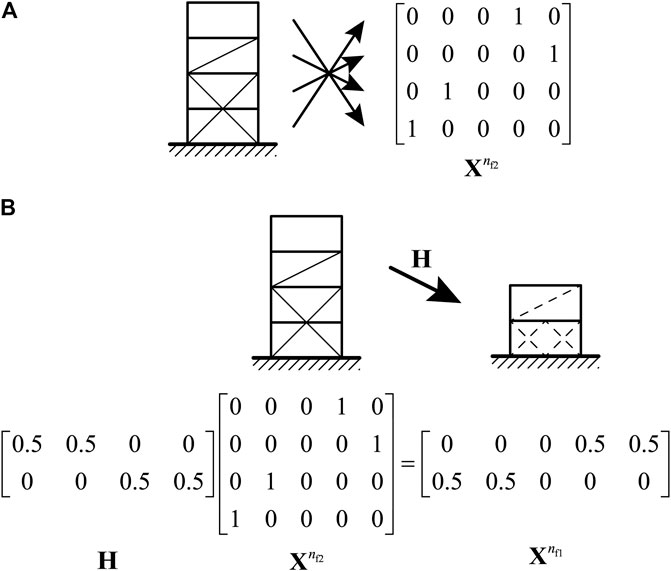
FIGURE 3. Illustration of the condensation process; (A) example of
The
Let
where
Numerical Examples
Description of frames
We investigate the properties of a 24-story 4-span frame using the machine learning results of a 12-story 4-span frame. The horizontal seismic loads are assigned based on the building code in Japan. To evaluate the axial forces of beams, the assumption of a rigid floor is not used; instead, the axial stiffness of each beam is multiplied by 10 to the standard value incorporating the in-plane stiffness of the slab, without modifying its bending stiffness. The column base is rigidly supported, and the braces are rigidly connected to the beams and columns. The section shapes of beams and columns are wide-flange sections and square hollow structural sections, respectively. Young’s modulus of the steel material is 2.05 × 105 N/mm2, the upper bound of interstory drift angle is
The optimization process and frame analysis with the standard Euler-Bernoulli beam-column elements are carried out using MATLAB R2016b (MathWorks, 2016). The function fitcsvm in the Statics and Machine Learning Toolbox is used for machine learning, and SQP of fmincon in the Optimization Toolbox is used for solving problem Eq. 15. A PC with Intel Xeon E5-2643 v4, 3.40GHz, 64 GB memory is used for computation.
Properties of Small-Scale Frame
Approximate optimal and non-optimal solutions are classified for the 12-story 4-span frame as shown in Figure 1. The story height is 3 m and the span is 6 m. The member sections are listed in Table 1, where A is the cross-sectional area and I is the second moment of area. The symbols H, L, and HSS indicate wide-flange section, L-section, and hollow structural section, respectively. The horizontal loads
First, we investigate the effect of the value of the box constraint parameter

TABLE 2. Error ratio and numbers of FN, FP, SV, and SV with
The contribution of a feature, which represents the location and type of a brace, is evaluated using the method described in Identification of Important Features Section. For this purpose, we show that the variation of
The values of
The features related to the eight largest contributions to be judged as approximate optimal solution are shown in Figures 5A,B for linear and RBF kernels, respectively. Note that the maximum stress exists at the end of a brace in most of the approximate optimal solutions. As seen from the figure, similar features are found in the best solutions by using linear and RBF kernels. Let Li and Ri denote the features with the ith largest contribution in the results using linear and RBF kernels, respectively, computed by Eqs 7, 12. The number of samples containing the specific feature in approximate optimal and non-optimal solutions are denoted by
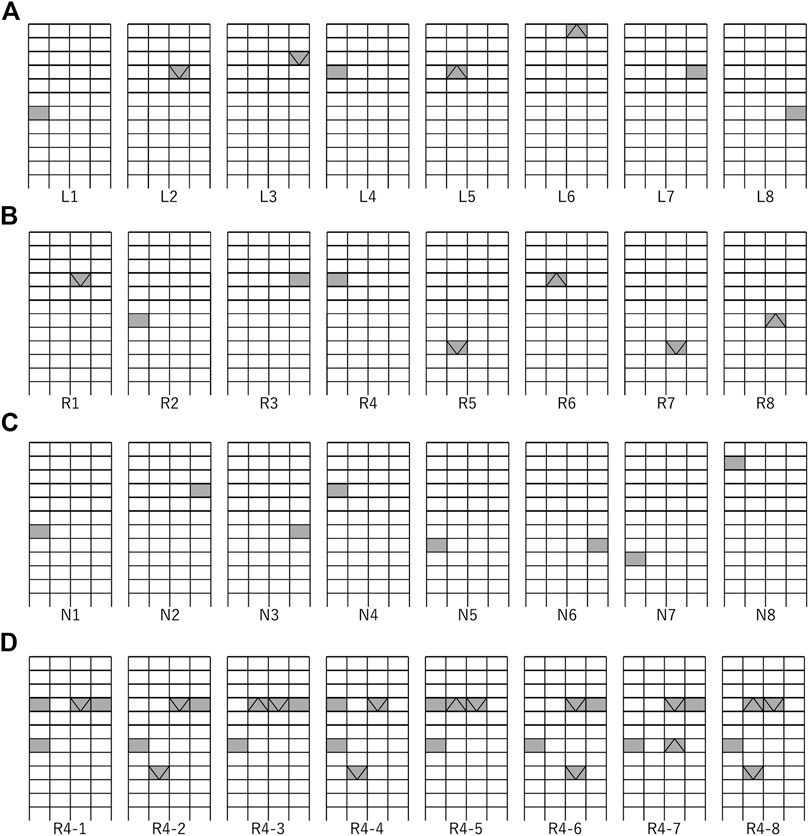
FIGURE 5. Features with the eight largest contributions to approximate optimal solution; (A) linear kernel, (B) RBF kernel, (C) number of samples given as
The sets of four features corresponding to the eight largest contributions to the approximate optimal solution are plotted in Figure 5D. As seen from the figure, the existence of K- and V-braces in the interior spans of the 4th and 9th stories, as well as non-existence of brace in the outer spans, is important to be classified as an approximate optimal solution.
Application of machine learning results of 12-story frame to 24-story frame.
The machine learning results of the 12-story frame are utilized for optimization of brace locations of a 24-story frame. The story height and span are the same as those of the 12-story frame, which are 3 m and 6 m, respectively. The seismic loads
The optimization problem Eq. 15 is solved with the parameter
The errors of application of machine learning results of a 12-story frame to predict the score value of the 24-story frame are shown in Table 6. The RBF kernel is used with the box parameter
Figure 6 shows the distribution of scores of approximate optimal and non-optimal solutions of the 24-story frame utilizing the machine learning results of the 12-story frame. It is confirmed that most of the approximate optimal and non-optimal solutions are separated successfully by the score value 0.

FIGURE 6. Relation between maximum stress of the 24-story frame and the score; (A) linear kernel, (B) RBF kernel.
Since the frame without a brace is symmetric with respect to the center vertical axis, we can assume that the optimal solution is also symmetric. Therefore, the four best and worst symmetric solutions are selected as shown in Figure 7, where the thick line indicates the member with the maximum stress value. We can see from these results that the approximate optimal solutions have braces in the inner span, while many braces are located in the outer span of the non-optimal solutions. Note again that the purpose of this paper is to extract the important features of the approximate optimal solutions. Therefore, we do not intend to optimize the brace locations using the machine learning results only. The learning results will be effectively used in an optimization process as demonstrated in our previous study (Tamura et al., 2018). It is true that the best solutions in Figure 7 are not realistic and large cost will be needed for construction. However, the features in each best solution, not the solution itself, will be utilized for optimization purposes.
In the same manner as the 12-story frame, contribution of the feature is defined in the descending order of the value of
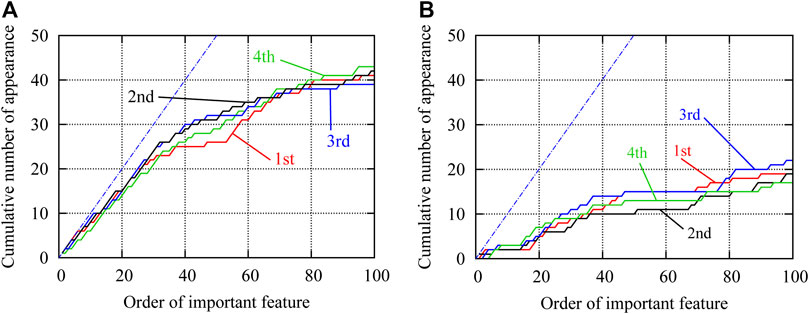
FIGURE 8. Cumulative numbers of appearance of important features existing in the approximate optimal solutions; (A) approximate optimal solutions, (B) non-optimal solutions.
Note that
Number of appearances of features corresponding to the 100 largest contributions to be predicted as approximate optimal solutions are plotted in Figure 9A for the 1,000 approximate optimal solutions classified by utilizing the learning results of the 12-story frame. Note that the large number (around 500–700) of appearances correspond to “no-brace”, and the small numbers (around 200) correspond to the existence of a specific brace that may be doubled if symmetrically located cases are regarded as the same. Figure 9B shows the difference in number of appearances using results of the 12-story frame and direct learning of the 24-story frame, where the latter has larger numbers for all features. It is seen from the figure that the number of appearances for the two cases are almost the same (the maximum difference is four). Therefore, we can conclude that the properties of the approximate optimal solutions of the 24-story frame can be successfully extracted using the machine learning results of the 12-story frame.
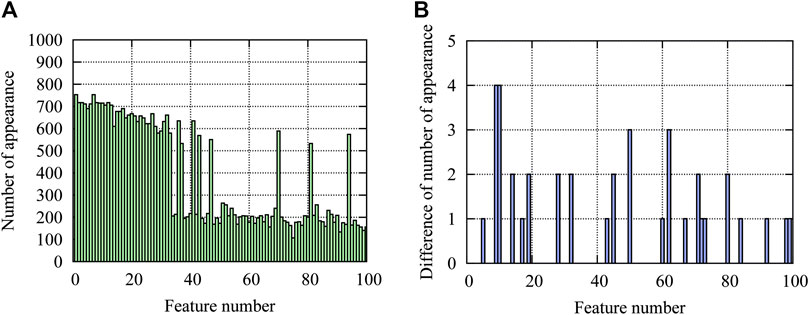
FIGURE 9. Numbers of appearance of features corresponding to the 100 largest contributions to approximate optimal solutions; (A) number of appearance using results of a 12-story frame, (B) difference in numbers of appearance using results of a 12-story frame and direct learning of a 24-story frame.
Conclusion
A method has been presented for extracting important features of the approximate optimal types and locations of braces for a large-scale steel plane frame. A process of seismic retrofitting is assumed and the maximum stress against horizontal seismic loads is minimized under constraints on the maximum interstory drift angle and the number of braces in each story.
The SVM is used for classifying the solutions into approximate optimal and non-optimal solutions. The features representing the types and locations of the braces of a large-scale frame are converted to those of a small-scale frame using a condensation matrix, and its components are identified by minimizing (maximizing the negative value) the correlation between the score and the objective function value. The sum of squares of the score values in the FN and FP solutions are also included in the objective function to determine the appropriate bias value.
A method has also been proposed for identifying the important features of the approximate optimal solutions classified by SVM with RBF kernel functions, where the approximate increase of the score value due to the existence of the specific feature is utilized. Accuracy of this estimation method has been confirmed using the machine learning results of a 12-story frame. The appropriate value of the box parameter has also been investigated.
It has been shown in the numerical examples that the machine learning results of a small-scale (12-story) frame can be successfully used for estimating the properties of the approximate optimal and non-optimal solutions of a large-scale (24-story) frame. A clear difference exists in the cumulative number of appearances of the important features in the approximate optimal solutions and the non-optimal solutions, and each important feature exists in a large number of approximate optimal solutions estimated by utilizing the learning results of the small-scale frame.
The proposed method can be effectively used in the design process of a large-scale braced frame. The results may be utilized for optimization using a heuristic approach in the same manner as our previous study (Tamura et al., 2018). Application to various types of optimization algorithms will be studied in our future research.
Data Availability Statement
The raw data supporting the conclusions of this article will be made available by the authors, without undue reservation.
Author Contributions
KS designed the study, implemented the program, and wrote the initial draft of the manuscript. MO contributed problem formulation and interpretation of data, and assisted preparation of the final manuscript. TK evaluated the results in view of practical design requirements. All authors approved the final manuscript, and agreed to be accountable for the content of the work.
Funding
This study is partly supported by JSPS KAKENHI No. JP18K18898 and JP20H04467.
Conflict of Interest
The authors declare that the research was conducted in the absence of any commercial or financial relationships that could be construed as a potential conflict of interest.
References
Abe, S. (2007). Sparse least squares support vector training in the reduced empirical feature space. Pattern Anal. Appl. 10 (3), 203–214. doi:10.1007/s10044-007-0062-1
Abueidda, D. W., Koric, S., and Sobh, N. A. (2020). Topology optimization of 2D structures with nonlinearities using deep learning. Comput. Struct. 237, 106283. doi:10.1016/j.compstruc.2020.106283
Adeli, H. (2001). Neural networks in civil engineering: 1989–2000. Comp. Aid. Civil Infrastruct. Eng. 16 (2), 126–142. doi:10.1111/0885-9507.00219
Bai, Y., Wang, J., Liu, Y., and Lin, X. (2017). Thin-walled CFST columns for enhancing seismic collapse performance of high-rise steel frames. Appl. Sci. 7 (1), 53–65. doi:10.3390/app7010053
Beghini, L. L., Beghini, A., Katz, N., Baker, W. F., and Paulino, G. H. (2014). Connecting architecture and engineering through structural topology optimization. Eng. Struct. 59, 716–726. doi:10.1016/j.engstruct.2013.10.032
Cang, R., Yao, H., and Ren, Y. (2019). One-shot generation of near-optimal topology through theory-driven machine learning. Comput. Aided Des. 109, 12–21. doi:10.1016/j.cad.2018.12.008
Carmona, L., Sánchez, P., Salvador, J., and Ana, F. (2012). Mathematical methodologies in pattern recognition and machine learning. Berlin, Germany: Springer.
Cristianini, N., and Shawe-Taylor, J. (2000). An introduction to support vector machines. Cambridge, UK: Cambridge University Press.
Dai, H., and Cao, Z. (2017). A wavelet support vector machine-based neural network metamodel for structural reliability assessment. Comput. Aided Civ. Infrastruct. Eng. 32 (4), 344–357. doi:10.1111/mice.12257
Do, B., and Ohsaki, M. (2020). Gaussian mixture model for robust design optimization of planar steel frames. Struct. Multidiscip. Optim. 63, 137–160. doi:10.1007/s00158-020-02676-3
Hagishita, T., and Ohsaki, M. (2008a). Optimal placement of braces for steel frames with semi-rigid joints by scatter search. Comput. Struct. 86, 1983–1993. doi:10.1016/j.compstruc.2008.05.002
Hagishita, T., and Ohsaki, M. (2008b). Topology mining for optimization of framed structures. Jamdsm 2 (3), 417–428. doi:10.1299/jamdsm.2.417
Hayashi, K., and Ohsaki, M. (2020b). Reinforcement learning and graph embedding for binary truss topology optimization under stress and displacement constraints. Front. Built Environ., Specialty Section: Computational Methods in Structural Engineering 6Paper No. 59. doi:10.3389/fbuil.2020.00059
Hayashi, K., and Ohsaki, M. (2020a). Reinforcement learning for optimum design of a plane frame under static loads. Engineering with Computers. doi:10.1007/s00366-019-00926-7
Kallioras, N. A., Kazakis, G., and Lagaros, N. D. (2020). Accelerated topology optimization by means of deep learning. Struct. Multidiscip. Optim. 62, 1185–1212. doi:10.1007/s00158-020-02545-z
Kanno, Y., and Guo, X. (2010). A mixed integer programming for robust truss topology optimization with stress constraints. Int. J. Numer. Methods Eng. 83, 1675–1699. doi:10.1002/nme.2871
Kennedy, J., and Eberhart, R. C. (1995). “Particle swarm optimization”, in Proceedings of the 1995 IEEE international conference on neural networks. Perth, Australia, 1942–1948.
Kim, M., Araki, Y., Yamakawa, M., Tagawa, H., and Ikago, K. 2009). Influence of P-delta effect on dynamic response of high-rise moment-resisting steel buildings subject to extreme earthquake ground motions. Nihon Kenchiku Gakkai Kozokei Ronbunshu 74 (644), 1861–1868. doi:10.3130/aijs.74.1861 (in Japanese).
Kim, S. H., and Boukouvala, F. (2020). Machine learning-based surrogate modeling for data-driven optimization: a comparison of subset selection for regression techniques. Opt. Lett. 14, 989–1010. doi:10.1007/s11590-019-01428-7
Lei, X., Liu, C., Du, Z., Zhang, W., and Guo, X. (2018). Machine learning-driven real-time topology optimization under moving morphable component -based framework, J. Appl. Mech. 86 (1), 1–9. doi:10.1115/1.4041319
Li, H.-S., Lü, Z.-Z., and Yue, Z.-F. (2006). Support vector machine for structural reliability analysis. Appl. Math. Mech. 27, 1295–1303. doi:10.1007/s10483-006-1001-z
Liu, K., Detwiler, D., and Tovar, A. (2017a). Optimal design of nonlinear multimaterial structures for crashworthiness using cluster analysis. J. Mech. Des. 138, 1–11. 10.1115/1.4037620
Liu, X., Wu, Y., Wang, B., Ding, J., and Jie, H. (2017b). An adaptive local range sampling method for reliability-based design optimization using support vector machine and Kriging model. Struct. Multidiscip. Optim. 55, 2285–2304. doi:10.1007/s00158-016-1641-9
Luo, H., and Paal, S. G. (2019). A locally weighted machine learning model for generalized prediction of drift capacity in seismic vulnerability assessments. Comput. Aided Civ. Infrastruct. Eng. 34, 935–950. doi:10.1111/mice.12456
Nabian, M. A., and Meidani, H. (2018). Deep learning for accelerated seismic reliability analysis of transportation networks. Comput. Aided Civ. Infrastruct. Eng. 33 (6), 443–458. doi:10.1111/mice.12359
Nguyen, T., Kashani, A., Ngo, T., and Bordas, S. (2019). Deep neural network with high-order neuron for the prediction of foamed concrete strength. Comput. Aided Civ. Infrastruct. Eng. 34, 316–332. doi:10.1111/mice.12422
Okazaki, Y., Okazaki, S., Asamoto, S., and Chun, P.-J. (2020). Applicability of machine learning to a crack model in concrete bridges. Comput. Aided Civ. Infrastruct. Eng. 35 (8). 10.1111/mice.12532
Panakkat, A., and Adeli, H. (2009). Recurrent neural network for approximate earthquake time and location prediction using multiple seismicity indicators. Comput. Aided Civ. Infrastruct. Eng. 24 (4), 280–292. doi:10.1111/j.1467-8667.2009.00595.x
Papadrakakis, M., Lagaros, N. D., and Tsompanakis, Y. (1998). Structural optimization using evolution strategies and neural networks. Comput. Methods Appl. Mech. Eng. 156 (1–4), 309–333. doi:10.1016/s0045-7825(97)00215-6
Rahmatalla, S., and Swan, C. C. (2003). Form finding of sparse structures with continuum topology optimization. J. Struct. Eng. 129 (12), 1707–1716. doi:10.1061/(asce)0733-9445(2003)129:12(1707)
Saka, M. P., and Geem, Z. W. (2013). Mathematical and metaheuristic applications in design optimization of steel frame structures: an extensive review. Math. Probl. Eng. 2013. 10.1155/2013/271031
Senhola, F. V., Giraldo-Londoño, O., Menezes, I. F. M., and Paulino, G. H. (2020). Topology optimization with local stress constraints: a stress aggregation-free approach. Struct. Multidisc. Optim. 62, 1639–1668. doi:10.1007/s00158-020-02573-9
Smola, A. J., and Schölkopf, B. (2004). A tutorial on support vector regression. Stat. Comput. 14, 199–222. doi:10.1023/b:stco.0000035301.49549.88
Szczepanik, W., Arciszewski, T., and Wnek, J. (1996). Empirical performance comparison of selective and constructive induction. Eng. Appl. Artif. Intell. 9 (6), 627–637. doi:10.1016/s0952-1976(96)00057-7
Tamura, T., Ohsaki, M., and Takagi, J. (2018). Machine learning for combinatorial optimization of brace placement of steel frames. Jpn. Archit. Rev. 1 (4), 419–430. doi:10.1002/2475-8876.12059
Turan, O., and Philip, S. (2012). Learning-based ship design optimization approach. Comput. Aided Des. 44 (3), 186–195. doi:10.1016/j.cad.2011.06.011
U. Stańczyk, and L. C. Jain (2015). Feature selection for data and pattern recognition (Berlin, Germany: Springer).
Witten, I. H., Frank, E., and Hall, M. A. (2011). Data mining: practical machine learning tools and techniques. Amsterdam, Netherlands: Elsevier.
Xiong, H., Swamy, M. N., and Ahmad, M. O. (2005). Optimizing the kernel in the empirical feature space. IEEE Trans. Neural Network. 16 (2), 460–474. doi:10.1109/TNN.2004.841784
Yonekura, K., and Hattori, H. (2019). Framework for design optimization using deep reinforcement learning. Struct. Multidiscip. Optim. 60, 1709–1713. doi:10.1007/s00158-019-02276-w
Keywords: machine learning, steel frame, brace, optimal location, support vector machine
Citation: Sakaguchi K, Ohsaki M and Kimura T (2021) Machine Learning for Extracting Features of Approximate Optimal Brace Locations for Steel Frames. Front. Built Environ. 6:616455. doi: 10.3389/fbuil.2020.616455
Received: 12 October 2020; Accepted: 16 December 2020;
Published: 05 February 2021.
Edited by:
Yao Chen, Southeast University, ChinaCopyright © 2021 Sakaguchi, Ohsaki and Kimura. This is an open-access article distributed under the terms of the Creative Commons Attribution License (CC BY). The use, distribution or reproduction in other forums is permitted, provided the original author(s) and the copyright owner(s) are credited and that the original publication in this journal is cited, in accordance with accepted academic practice. No use, distribution or reproduction is permitted which does not comply with these terms.
*Correspondence: Makoto Ohsaki, b2hzYWtpQGFyY2hpLmt5b3RvLXUuYWMuanA=
 Kazuma Sakaguchi
Kazuma Sakaguchi Makoto Ohsaki
Makoto Ohsaki Toshiaki Kimura
Toshiaki Kimura